
CET1171 Students Home Page - Main Links
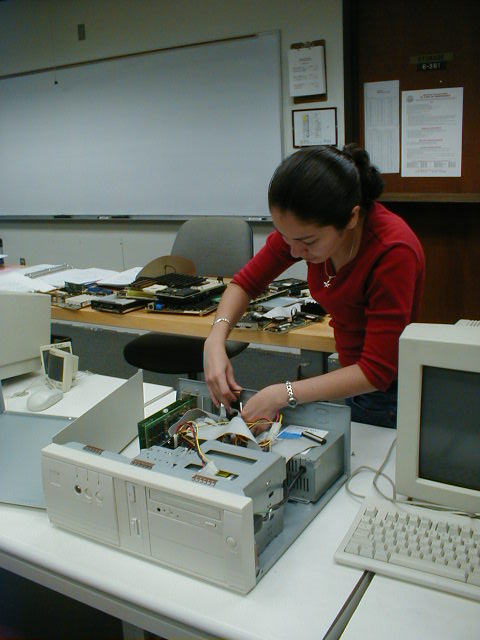
Student busy disassembling a PC in CET1171
Introduction to Microcomputer Service and Mainenance.
All practice tests are now available from this portal.
Only attempt one after all it's modules have been covered!
Online Practice Test Portal(being updated)
CET1171 Practice Test #7 - Part ID New!
CET1171 Course Description
College Catalog Description:(This course is under revision)
Introduction to the service and maintenance techniques for personal computers. Intended to address the non-technical student who has a need to know more about personal computers. Topics include faults in the CPU, disk drives, cables, monitors and software. Laboratory fee. A.S. degree credit only. (3 hr. lecture)
Brief Decription from the Professor:
This is a gentle introduction to PC repair. Topics begin with non-technical descriptions of electricity, transistors, logic gates, binary number system and progress into descriptions of each component of the PC and how it works. The objective is that the student will have a basic understanding of how the PC works, how each component works, and be able to identify and describe any component, be able to competently handle these components, be able to safely remove or install any component in a PC, and be capable of completely disassembling and reassembling a PC.
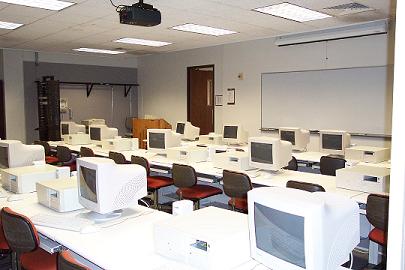
The Microcomputer Repair Program electronic classroom.
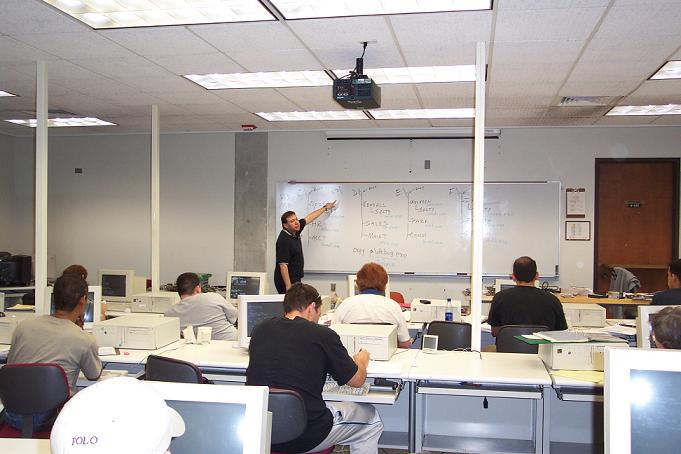
Prof. Calixto teaching the Network+ Certification course.
Getting Started in CET1171
Attendance is important in CET1171 because there will be plenty of real world hands on activities. Students should take notes despite the fact that I will provide them with direct email links to the lecture modules which contain everything needed to study from. Students should attempt to answer the questions at the end of each lecture module and be on time at the start of each class in order to be able to take the short quiz covering the topics of the end of lecture questions of the previous class module and turn this in to get the points for attendance for the class.
Textbook:
A+ Guide to Managing and Maintaining Your PC, 5th Ed. By Jean Andrews
ISBN:0-619-21324-8
Recommended Reading:
DOS: The Complete Reference, 3rd Ed. by Kris Jamsa ISBN:0078819040
How Computers Work, 6th Ed. By Ron White and Timothy Downs ISBN:0789725495
Upgrading and Repairing PC's, 17th Ed. By Scott Mueller ISBN:0789734044
Pocket PCRef, 12th Ed. By Thomas Glover & Millie Young ISBN:1885071388
Required Materials:
Toolkit with #2 Phillips screwdriver
Anti-static (ESD) wrist strap
Class Grade Computation:
The final grade for the class will be based on the following:
ITEM POINTS SCORE
ATTENDANCE + Daily Quiz:
3 pts/class X 16 classes = 48 + 2 free points
Worth up to 50 pts
(Daily quiz scores may be included in the attendance grade)
FINAL EXAM Part #1 (Written): Fundamental Computer Concepts and
Terminology, Safety and ESD; Computer Basics; Hardware
Identification; Personal Computer History, Terminology and Design;
Basic Computer Operations
Worth 25 pts
FINAL EXAM Part #2 (Practical): Technical Skills
Computer Disassembly, Component Inventory,
Reassembly, CMOS Configuration, Hard Drive Setup
Worth 25 pts
TOTAL: 100 pts
CET1171 Course Objectives and Coverage
Course Skills & Objectives:
Students shall learn to assemble and disassemble computers; perform basic computer maintenance and service; develop basic troubleshooting skills; learn to use basic tools; learn the associated terminology, acronyms and their meanings; and complete the Course with a final grade of “C” or higher.
Coverage:
The Course covers the design, construction, maintenance and servicing of the IBM based microcomputer. Students will study the BIOS, CMOS, I/O, CPU, memory, System Bus, System Resources, Industry Standard Architecture, expansion adapters, video; safety and tool handling; identification and function of computer components; the assembly and disassembly of Intel based computers; component installation and setup; hard drive installation and setup.
Lecture #1: Definition of a Computer - define computer, modern digital electronic computer, special and general purpose computer, classes of general purpose computer, microcomputer, microprocessor, machine language and data, information, files, etc.
Lecture #2: Electicity - define electricity, potential, static electricity, electrostatic discharge, anti-static tools and procedures for their usage, etc.
Lecture #3: Number systems and Units of Measure - define bit, byte, word, double word, quad word, metric and binary prefixes, cover the binary and hexadecimal number systems, etc.
Lecture #4: Transistors - define and describe transistors, describe how they are combined to form logic gates, define and describe basic logic gates, describe how logic gates are combined to form circuits that can perform complex computing tasks, etc.
Lecture #5: MPC '97 Specification - define and describe the basic concept of the MPC specifications, use these to form a complete parts list for designing and building complete working PC's, brief introductory description of each component of the PC, etc.
Lecture #6: Buses - define and describe the basic concept of the circuit bus, cover the foundational buses of the PC, define and describe the basic concepts of the PC motherboard, define and describe the fundamental differences between the AT and the ATX platforms, etc.
Lecture #7: CPU's - define and describe the basic concept and functionality of the microprocessor, define, describe and cover the evolution of the Intel x86 family of microprocessors from the 8088 to the first Pentium, etc.
Lecture #8: RAM - define and describe the basic concept and functionality of the system main memory, define, describe and cover the evolution of the memory technologies from the chips used in the first PC up to modern dual channel DDR2, etc.
Lecture #9: BIOS - define and describe the basic concept and functionality of the system BIOS, define and describe the BIOS hardware and software components and cover the evolution of the read only memory technologies from the basic ROM chip up to the modern dual BIOS EEPROM chip based systems, etc.
Lecture #10: Component Identification #1 - define and describe the external expansion connectors and their associated peripheral devices and expansion bus technologies, etc.
Lecture #11: Component Identification #2 - define and describe the internal expansion connectors and their associated peripheral devices and expansion bus technologies, etc.
Lecture #12: Magnetic Storage Technologies - define and describe the basic concepts of the magnetic storage technologies from the first floppy disk drives and media up to the modern EIDE/SATA hard drives, cover identification, capacity calculation, installation, etc.
Lecture #13: Disassemble/Reassemble a PC - define and describe the basic methodology of disassembling a PC, cover and practice hands on methods of disassembly and reassembly of the PC, etc.
Lecture #14: Design a Custom PC - The student will apply the knowledge and skills learned during the course to design custom PC's targeted for specific missions, etc.
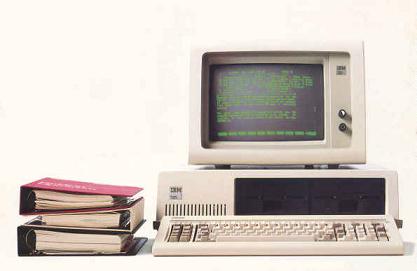
The First model of the IBM PC
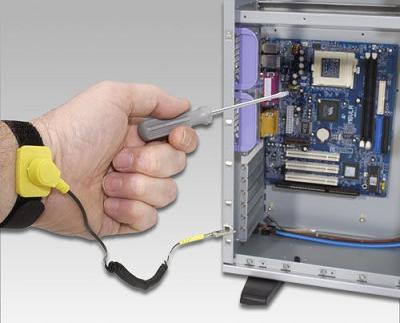
The Anti-static wrist strap
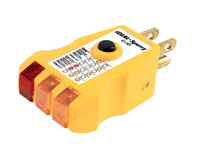
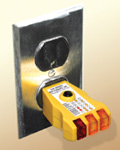
The Typical AC Wall Outlet Tester